Reconstructing Energy-Efficient Buildings after a Major Earthquake in Hatay, Türkiye
Abstract
:1. Introduction
2. Methods
2.1. Climate and Location Analysis
2.2. Case Building Design
2.3. Energy Simulation Analysis
2.4. Retrofitting Strategies
2.4.1. Case One: Adding Photovoltaic (PV) Panels
2.4.2. Case Two: Building-Integrated Wind Turbine Design
- : power output (watts).
- : air density (kg/m3).
- : swept area (m2).
- : wind speed (m/s).
- : torque (N.m).
- : radius of the rotor (m).
- : angular velocity (rad/s).
2.4.3. Case Three: Green Structure Applications
3. Results and Discussion
4. Conclusions
Author Contributions
Funding
Data Availability Statement
Conflicts of Interest
References
- Leventeli, Y.; Yilmazer, O.; Yilmazer, I. The importance of effective land use planning for reduction in earthquake catastrophe. Arab. J. Geosci. 2020, 13, 1010. [Google Scholar] [CrossRef]
- Republic of Türkiye, Ministary of Environment. Urbanization and Climate Change. Available online: https://kamuguclendirme.csb.gov.tr/en/general-information-of-the-project-i-109613 (accessed on 6 June 2024).
- FEMA. Methodology. In Seismic Performance of Buildings; FEMA Publication No. P-58-1; Applied Technology Council: Redwood City, CA, USA, 2012; Volume 1. [Google Scholar]
- Calvi, G.M.; Sousa, L.; Ruggeri, C. Energy Efficiency and Seismic Resilience: A Common Approach. In Multi-Hazard Approaches to Civil Infrastructure Engineering; Springer: Berlin/Heidelberg, Germany, 2016; Chapter 9. [Google Scholar]
- Ayan, A.; Senturk, A.E. Exploring of Biomass Energy Specific to Turkey and on a Global Scale. Int. J. Renew. Energy Res. 2023, 13, 1456–1472. [Google Scholar] [CrossRef]
- Smart Güneş Enerjisi Teknolojileri Araştırma Geliştirme Üretim Sanayi ve Ticaret Anonim Şirketi. Faaliyet Raporu 2023. Available online: https://www.smartsolar.com.tr/ (accessed on 30 May 2024).
- IEA. World Energy Outlook 2023; International Energy Agency: Paris, France, 2023; Available online: https://www.iea.org/reports/world-energy-outlook-2023 (accessed on 30 May 2024).
- IEA; IRENA; UN. Climate Change High-Level Champions. Breakthrough Agenda Report 2023: Accelerating Sector Transitions Through Stronger International Collaboration; International Energy Agency: Paris, France, 2023; Available online: https://www.iea.org/reports/breakthrough-agenda-report-2023 (accessed on 30 May 2024).
- Fathy, A.M.; Abdelhady, M.I.; Juma, F. The Architectural Tools in Reducing Energy Consumption of Residential Buildings in Hot Countries. Int. J. Appl. Eng. Res. 2020, 15, 135–143. [Google Scholar]
- Turhan, C.; Ghazi, S. Energy Consumption and Thermal Comfort Investigation and Retrofitting Strategies for an Educational Building: Case Study in a Temperate Climate Zone. J. Build. Des. Environ. 2023, 2, 16869. [Google Scholar] [CrossRef]
- Duzgun, B.; Aydinalp Koksal, M.; Bayindir, R. Assessing Drivers of Residential Energy Consumption in Turkey: 2000–2018. Int. J. Appl. Eng. Res. 2022, 17, 135–143. [Google Scholar] [CrossRef]
- Bilgili, M.; Şahin, B.; Kahraman, A. Wind energy potential in Antakya and İskenderun regions, Turkey. Renew. Energy 2004, 29, 1733–1745. [Google Scholar] [CrossRef]
- Saygin, D.; Hoffman, M.; Godron, P. How Turkey Can Ensure a Successful Energy Transition. Center for American Progress. July 2018. Available online: www.americanprogress.org (accessed on 20 April 2024).
- Acar, A.; Güllü, A.B.; Aksoy, H.; Çalışkan, R.Y.; Serhadlıoğlu, S.; Taranto, Y. Türkiye Enerji Dönüşümü Görünümü 2023; SHURA Enerji Dönüşümü Merkezi, Sabancı Üniversitesi: Istanbul, Turkey, 2024; ISBN 978-625-6956-40-7. Available online: https://www.shura.org.tr (accessed on 10 May 2024).
- International Energy Agency (IEA). Energy Policy Review Turkey 2021; IEA: Paris, France, 2021; Available online: www.iea.org/reports/energy-policy-review-turkey-2021 (accessed on 20 April 2024).
- Salhein, K.; Kobus, C.J.; Zhody, M. Forecasting Installation Capacity for the Top 10 Countries Utilizing Geothermal Energy by 2030. Thermo 2022, 2, 334–351. [Google Scholar] [CrossRef]
- PwC Türkiye. Dünyada ve Türkiye’de Güneş Enerjisi Sektörü; PwC: Mart, TX, USA, 2024; Available online: http://www.pwc.com.tr/ (accessed on 30 May 2024).
- IRENA. World Energy Transitions Outlook 2023: 1.5 °C Pathway; International Renewable Energy Agency: Abu Dhabi, United Arab Emirates, 2023; ISBN 978-92-9260-527-8. Available online: https://www.irena.org/publications (accessed on 30 May 2024).
- Varolgüneş, F.K. Post-disaster permanent housing: The case of the 2003 Bingöl earthquake in Turkey. Disaster Prev. Manag. Int. J. 2021, 30, 175–189. [Google Scholar] [CrossRef]
- Yön, B. Identification of failure mechanisms in existing unreinforced masonry buildings in rural areas after 4 April 2019 earthquake in Turkey. J. Build. Eng. 2021, 43, 102586. [Google Scholar] [CrossRef]
- Ozmen, H.B. A view on how to mitigate earthquake damages in Turkey from a civil engineering perspective. Res. Eng. Struct. Mater. 2021, 7, 1–11. [Google Scholar] [CrossRef]
- Işık, E.; Büyüksaraç, A.; Ekinci, Y.L.; Aydın, M.C.; Harirchian, E. The Effect of Site-Specific Design Spectrum on Earthquake-Building Parameters: A Case Study from the Marmara Region (NW Turkey). Appl. Sci. 2020, 10, 7247. [Google Scholar] [CrossRef]
- Aman, D.D.; Aytac, G. Multi-criteria decision making for city-scale infrastructure of post-earthquake assembly areas: Case study of Istanbul. Int. J. Disaster Risk Reduct. 2022, 67, 102668. [Google Scholar] [CrossRef]
- Atmaca, B.; Demir, S.; Günaydın, M.; Altunışık, A.C.; Hüsem, M.; Ateş, Ş.; Adanur, S.; Angın, Z. Lessons learned from the past earthquakes on building performance in Turkey. J. Struct. Eng. Appl. Mech. 2020, 3, 61–84. [Google Scholar] [CrossRef]
- Ozturk, M.; Arslan, M.H.; Dogan, G.; Ecemis, A.S.; Arslan, H.D. School buildings performance in 7.7 Mw and 7.6 Mw catastrophic earthquakes in southeast of Turkey. J. Build. Eng. 2023, 79, 107810. [Google Scholar] [CrossRef]
- Ozturk, M.; Arslan, M.H.; Korkmaz, H.H. Effect on RC buildings of 6 February 2023 Turkey earthquake doublets and new doctrines for seismic design. Eng. Fail. Anal. 2023, 153, 107521. [Google Scholar] [CrossRef]
- Tao, W.; Jie, C.; Yujiang, Z.; Xiaoqing, W.; Xuchuan, L.; Xiaoting, W.; Qingxue, S. Preliminary investigation of building damage in Hatay under February 6, 2023 Turkey earthquakes. Earthq. Eng. Eng. Vib. 2023, 22, 1010. [Google Scholar] [CrossRef]
- Alrwashdeh, S.S. Investigation of the energy output from PV panels based on using different orientation systems in Amman-Jordan. Case Stud. Therm. Eng. 2021, 28, 101580. [Google Scholar] [CrossRef]
- Burg, B.R.; Ruch, P.; Paredes, S.; Michel, B. Effects of radiative forcing of building integrated photovoltaic systems in different urban climates. Sol. Energy 2017, 147, 399–405. [Google Scholar] [CrossRef]
- Biyik, E.; Araz, M.; Hepbasli, A.; Shahrestani, M.; Yao, R.; Shao, L.; Essah, E.; Oliveira, A.C.; Del Caño, T.; Rico, E.; et al. A key review of building integrated photovoltaic (BIPV) systems. Eng. Sci. Technol. Int. J. 2017, 20, 833–858. [Google Scholar] [CrossRef]
- Maghrabie, H.M.; Elsaid, K.; Sayed, E.T.; Abdelkareem, M.A.; Wilberforce, T.; Olabi, A.G. Building-integrated photovoltaic/thermal (BIPVT) systems: Applications and challenges. Sustain. Energy Technol. Assess. 2021, 45, 101151. [Google Scholar] [CrossRef]
- Topal, A.; Özoğlu, B.; Ekşioğlu, D. The evaluation of factors in utilizing the potential of solar energy: The case of Turkey. Environ. Res. Technol. 2021, 4, 266–276. [Google Scholar] [CrossRef]
- Çeçen, M.; Yavuz, C.; Aksoy Tırmıkçı, C.; Sarıkaya, S.; Yanıkoğlu, E. Analysis and evaluation of distributed photovoltaic generation in electrical energy production and related regulations of Turkey. Clean Technol. Environ. Policy 2022, 24, 1321–1336. [Google Scholar] [CrossRef] [PubMed]
- Hajizadeh, S.; Seyis, S. Retrofit strategies for a nearly-zero energy residential building: A case study in Antalya, Türkiye. In Proceedings of the 3rd International Civil Engineering and Architecture Congress (ICEARC’23), Antalya, Türkiye, 12–14 October 2023; pp. 1–12. [Google Scholar] [CrossRef]
- Adan, H.K.; Filik, Ü.B. Performance Investigation of On-Grid Solar Photovoltaic System in Eskişehir/Turkey. DEÜ FMD 2021, 23, 557–566. [Google Scholar] [CrossRef]
- Turhan, C.; Saleh, Y.A.S. A Case Study for Small-Scale Vertical Wind Turbine Integrated Building Energy Saving Potential. J. Build. Des. Environ. 2024, 3, 28115. [Google Scholar] [CrossRef]
- Kottek, M.; Grieser, J.; Beck, C.; Rudolf, B.; Rubel, F. World Map of the Köppen-Geiger Climate Classification Updated. Meteorol. Z. 2006, 15, 259–263. [Google Scholar] [CrossRef] [PubMed]
- Zengin, G.; Koç, A.; Artaş, S.B.; Köse, Ö.; Koç, Y.; Yağlı, H. Comparative Analyses of the Solar Energy Potentials of Gaziantep, Konya and Hatay: A Case Study for 1 MW of Photovoltaic System. Int. J. Energy Eng. Sci. 2024, 9, 1–11. [Google Scholar]
- Global Wind Atlas. Available online: https://globalwindatlas.info/ar (accessed on 13 April 2024).
- Türk Standardları Enstitüsü. TS 825: Thermal Insulation Requirements for Buildings; Türk Standardları Enstitüsü: Ankara, Turkey, 2008; Available online: https://intweb.tse.org.tr (accessed on 2 May 2024).
- DesignBuilder Software Ltd. DesignBuilder, v.6.1.0.006. Available online: http://www.designbuilder.co.uk/ (accessed on 8 May 2024).
- SolidWorks. 2018. Available online: https://www.solidworks.com/ (accessed on 10 May 2024).
- ANSYS, Inc. ANSYS Fluent. 2020. Available online: https://www.ansys.com/ (accessed on 10 May 2024).
- Eltayesh, A.; Castellani, F.; Natili, F.; Burlando, M.; Khedr, A. Aerodynamic upgrades of a Darrieus vertical axis small wind turbine. Energy Sustain. Dev. 2023, 73, 126–143. [Google Scholar] [CrossRef]
- Zidane, I.F.; Ali, H.M.; Swadener, G.; Eldrainy, Y.A.; Shehata, A.I. Effect of Upstream Deflector Utilization on H-Darrieus Wind Turbine Performance: An Optimization Study. Alex. Eng. J. 2023, 63, 175–189. [Google Scholar] [CrossRef]

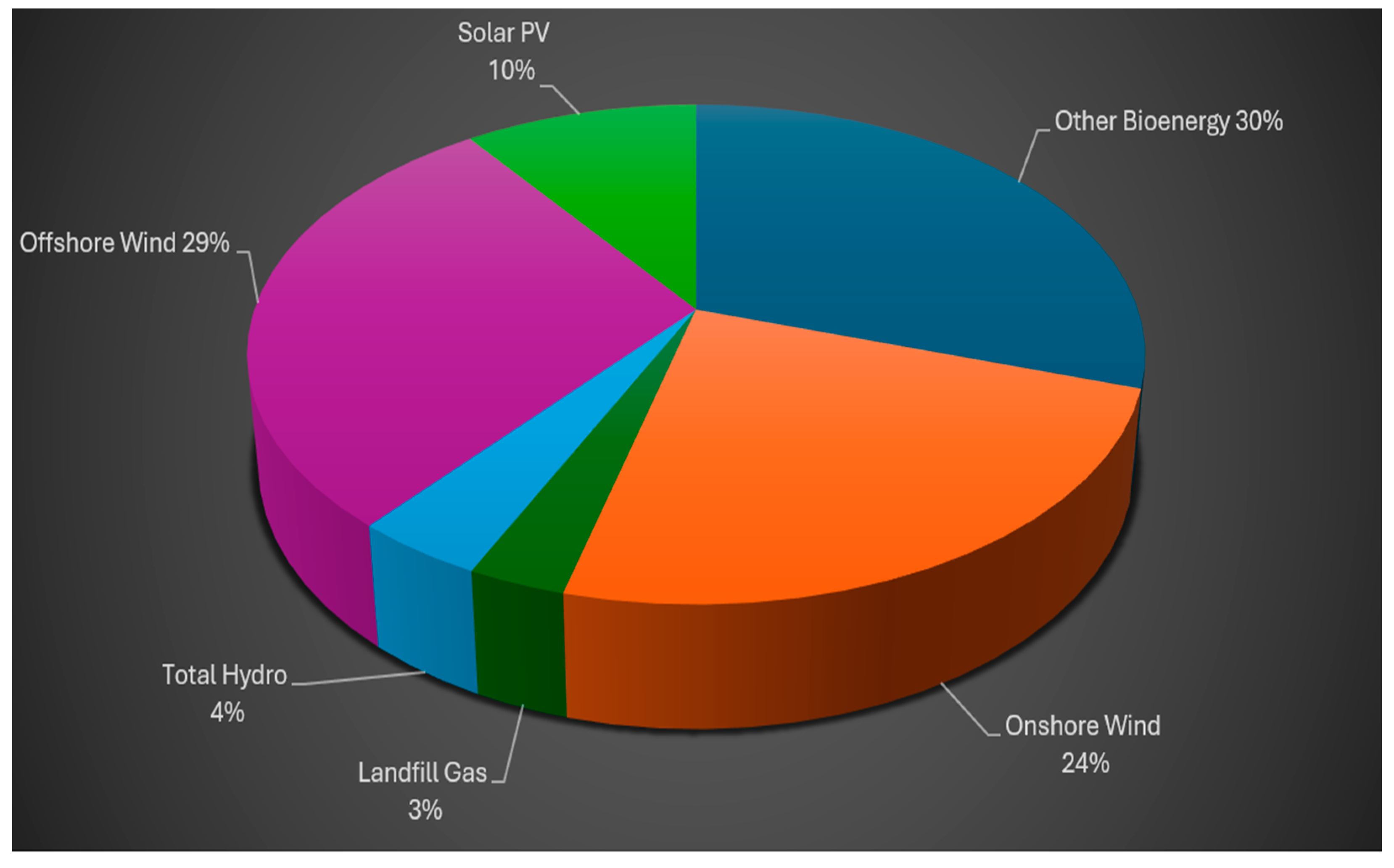
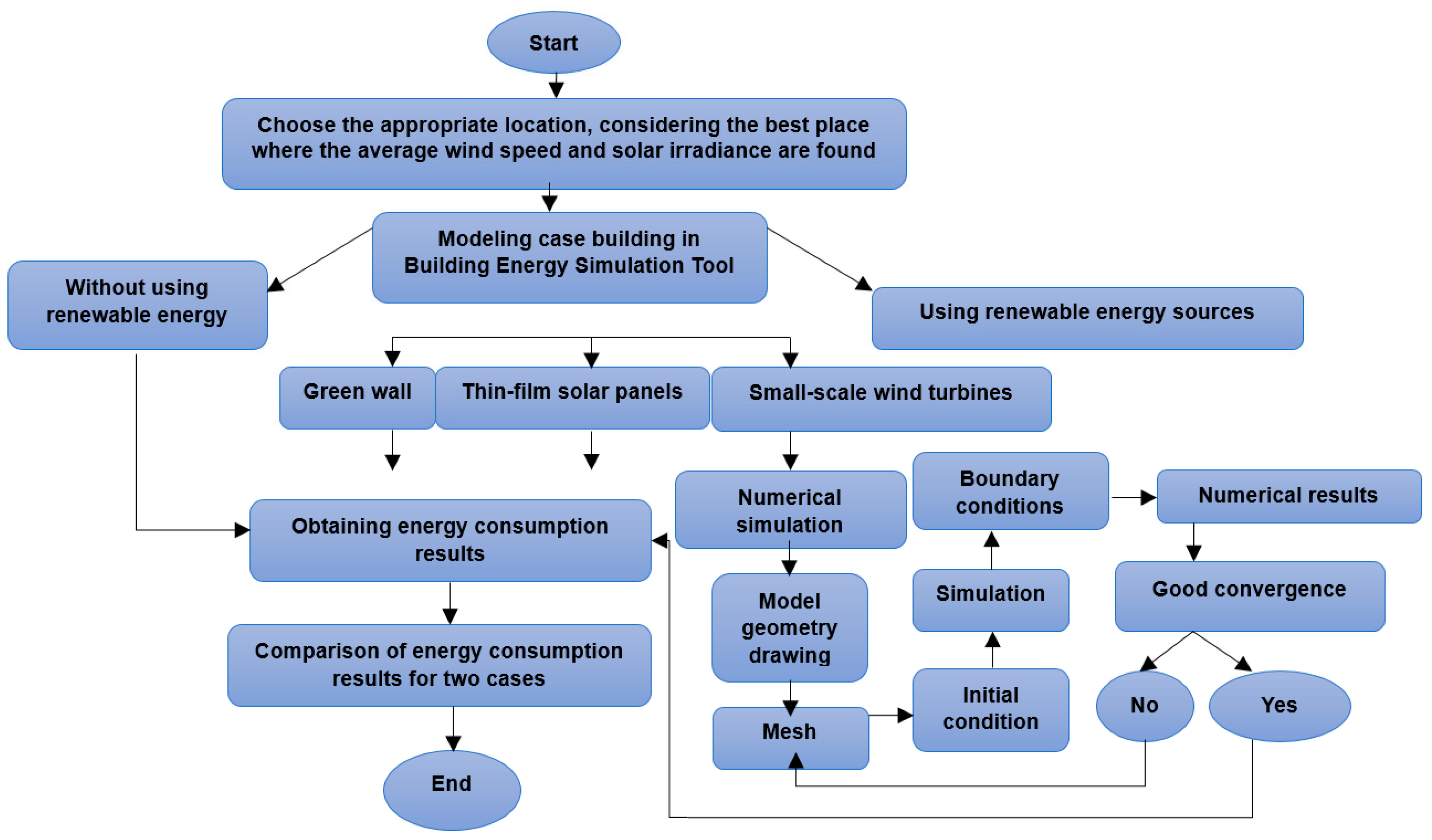

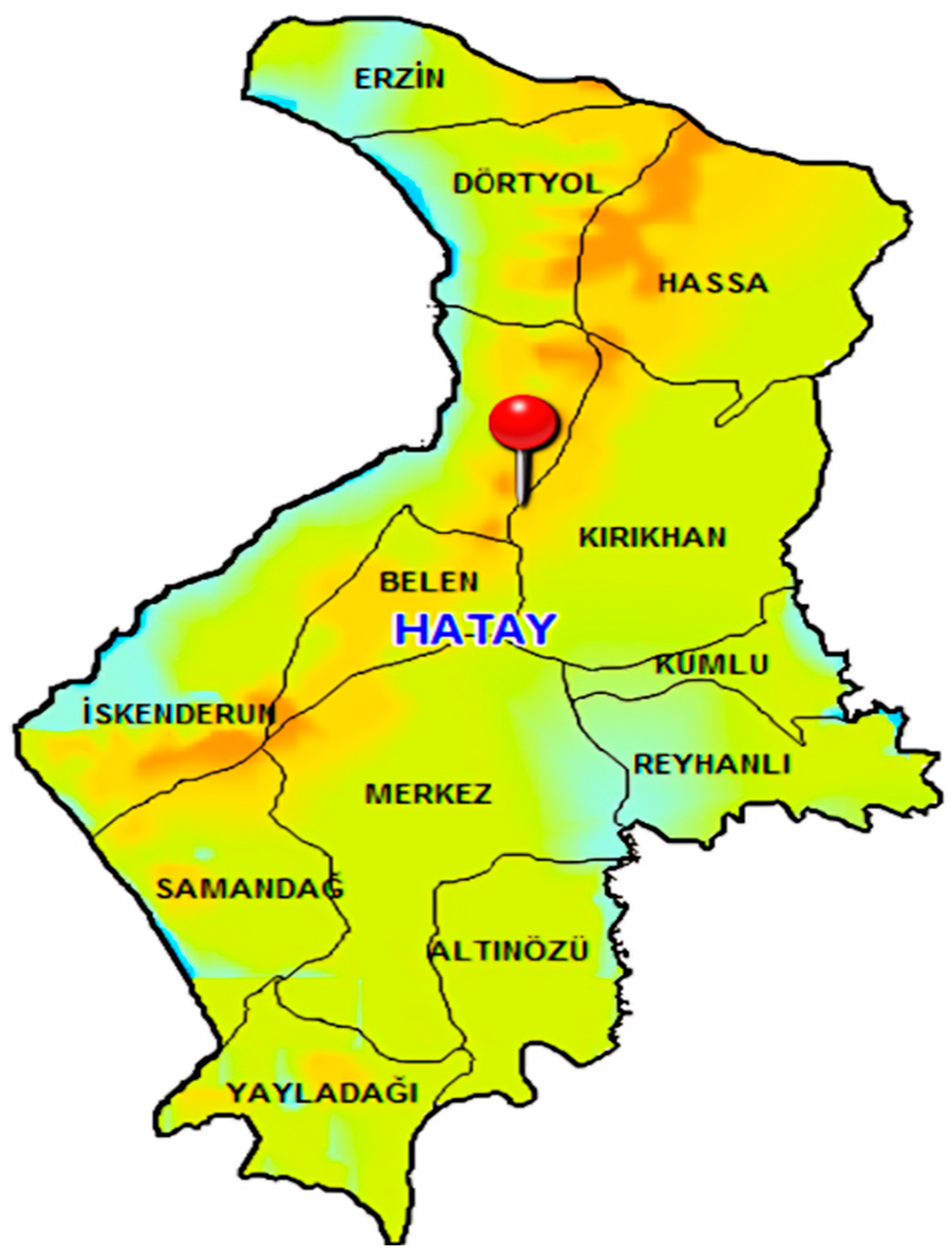
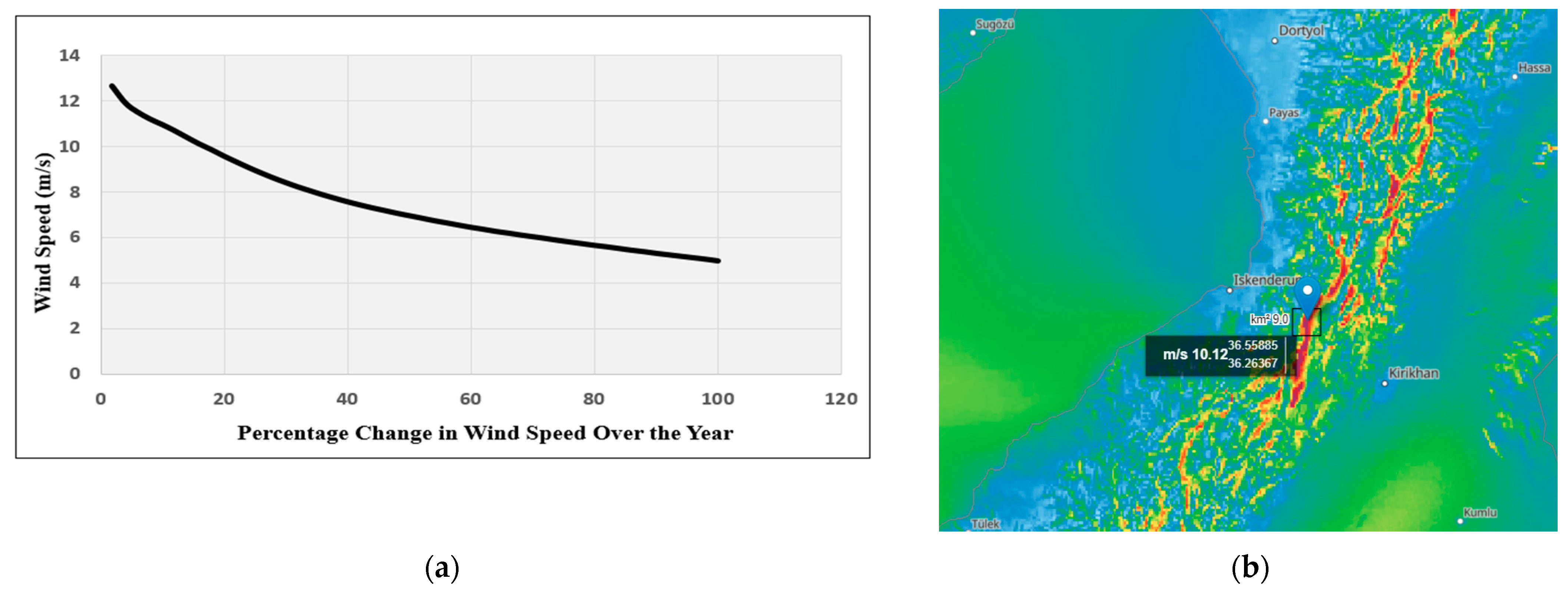

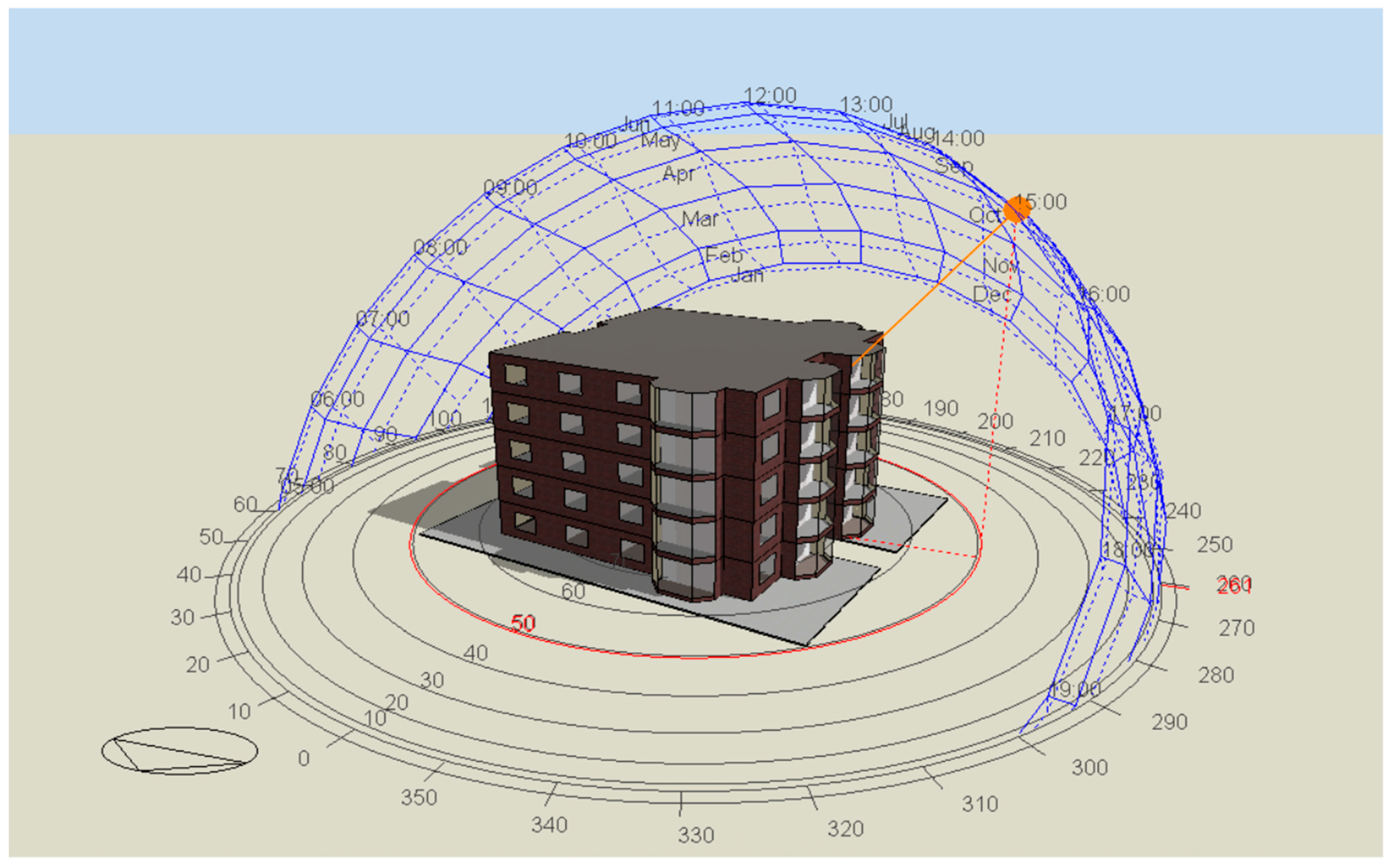
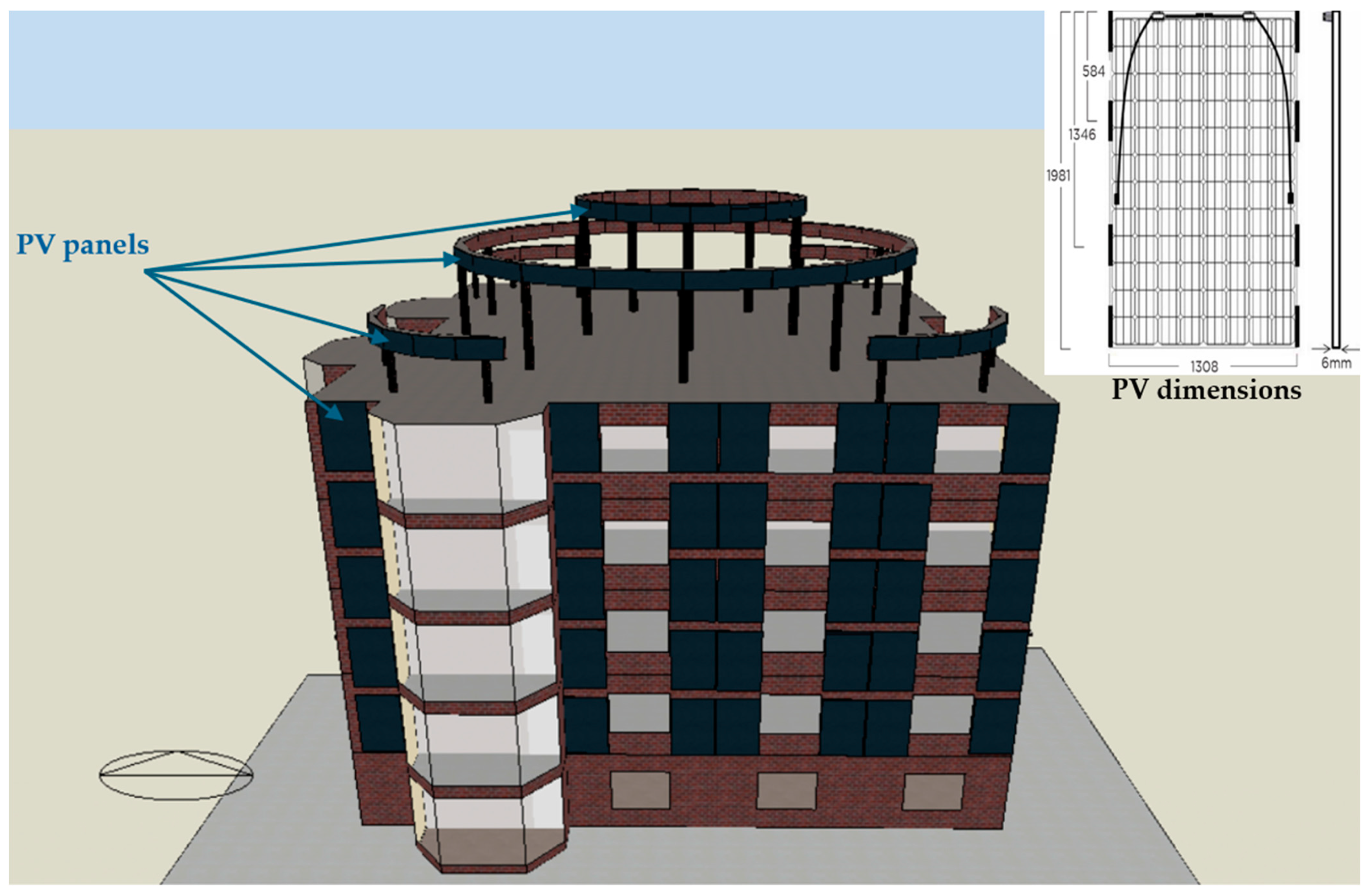

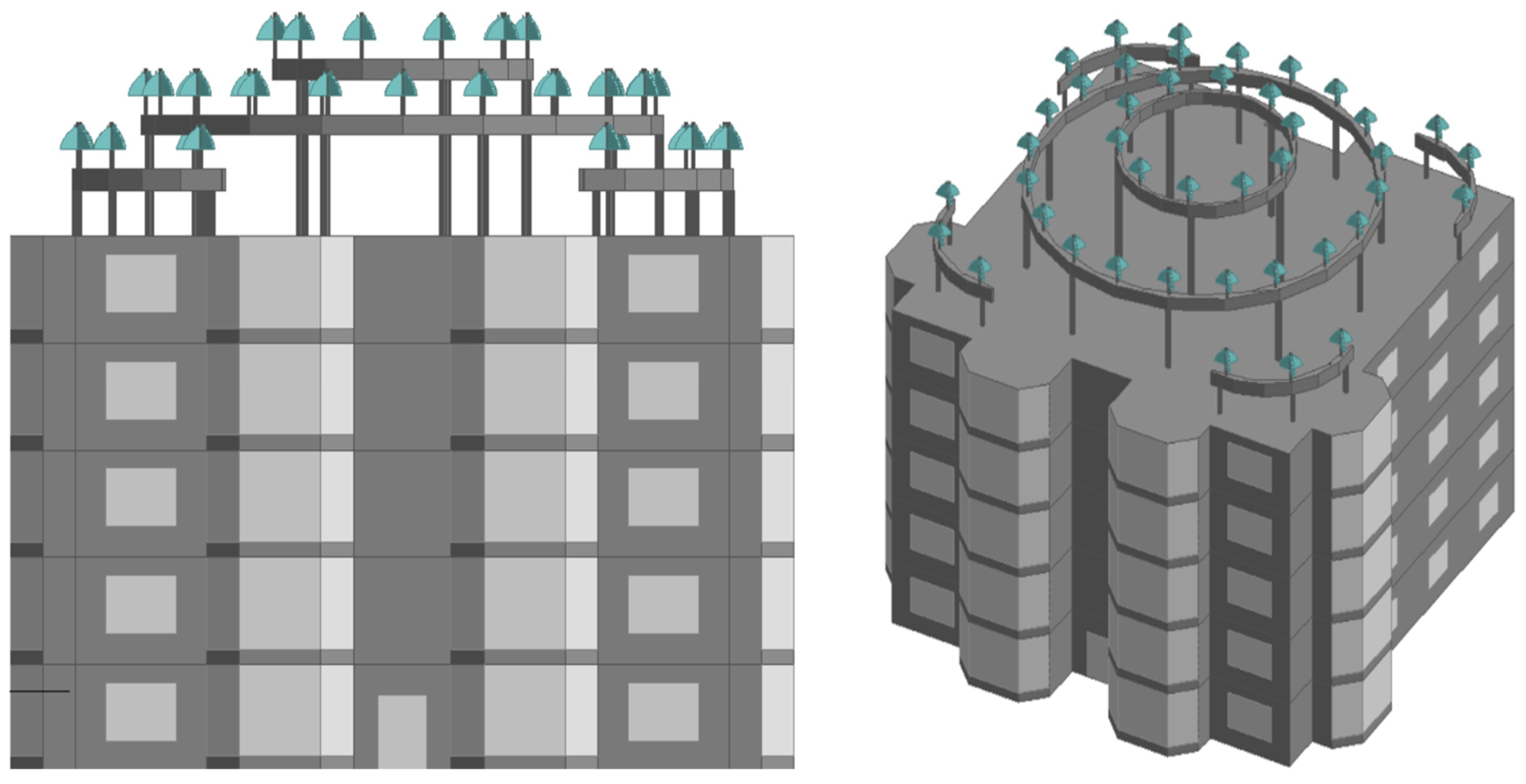
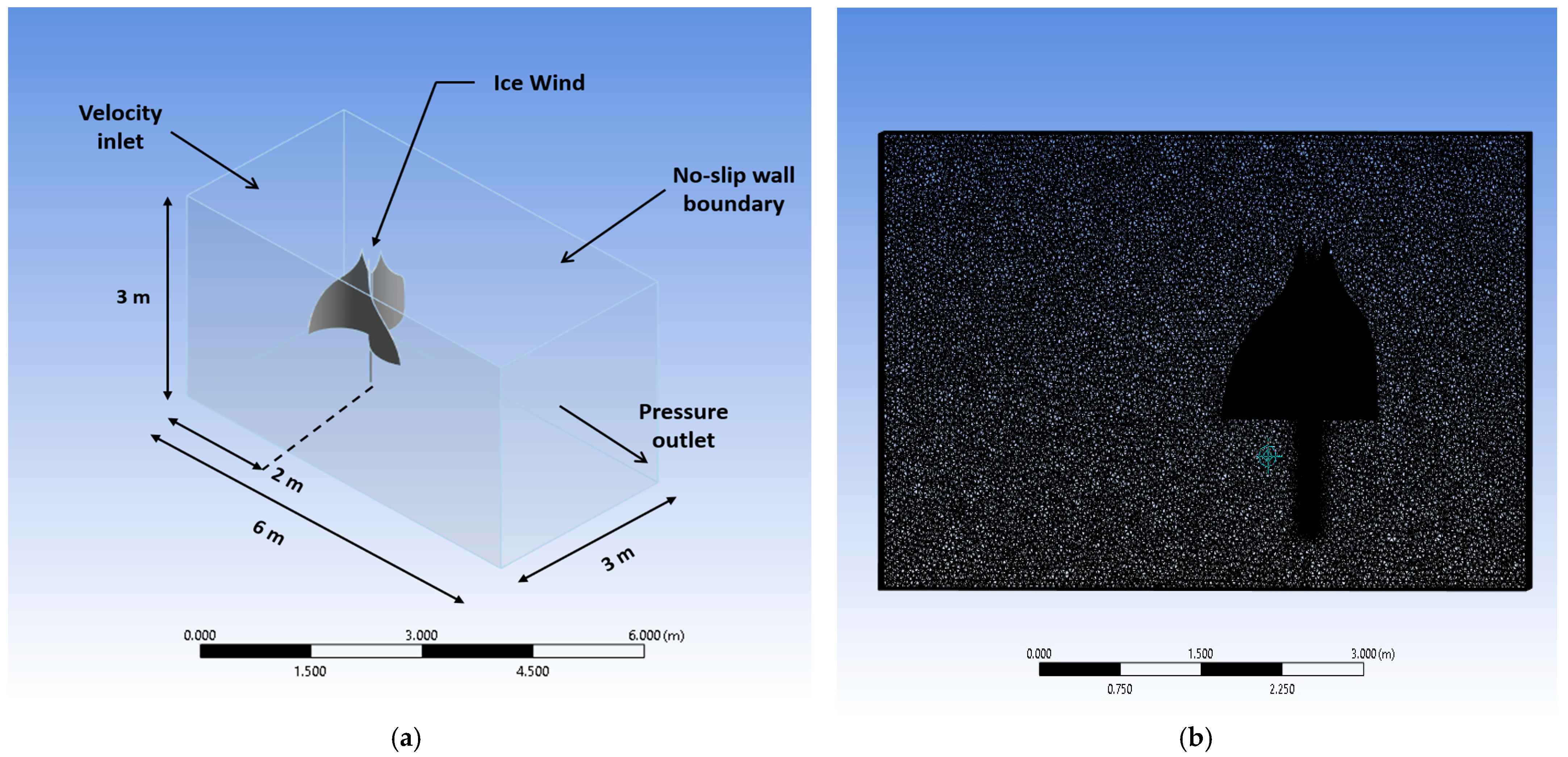


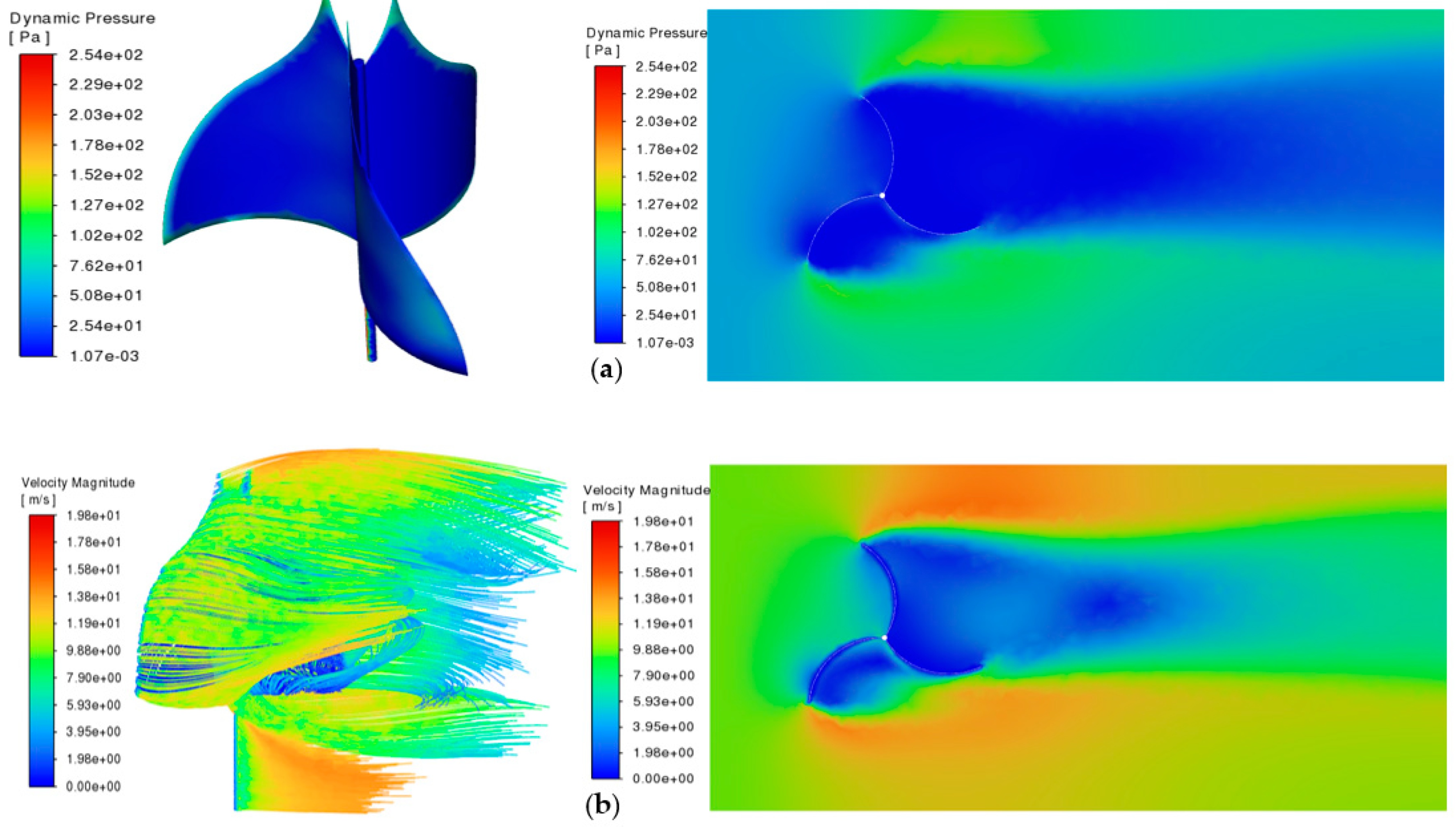
| The Building Construction Properties | Baseline Model |
|---|---|
| Number of floors | 5 |
| Overall floor area | 424 m2 |
| Number of spaces | 115 |
| External walls (U-value) | 0.35 (W/m2K) |
| Internal walls (U-value) | 1.923 (W/m2K) |
| Roof (U-value) | 0.25 (W/m2K) |
| Ground floor (U-value) | 0.25 (W/m2K) |
| Glazing type + U-value | Reference glazing with 1.978 (W/m2K) |
| Photovoltaic Properties | Photovoltaic Properties | ||
|---|---|---|---|
| Cell type | Bifacial Hybrid Cell Technology (HCT) | Rated electric power output per module (W) | 500 |
| Cells in series | 96 | Short-circuit current (A) | 9.3 |
| Active area m2 | 2.591148 | Module current at max power (A) | 8.8 |
| Total area of PV panels (m2) | 148.2 | Temperature coefficient of short-circuit current (A/K) | 0.00372 |
| Transmittance absorptance product | 0.9 | Module voltage at max power (V) | 57.4 |
| Semiconductor bandgap (eV) | 1.12 | Open-circuit voltage (V) | 72.9 |
| Reference temperature (°C) | 25 | NOCT cell temperature (°C) | 45 |
| Reference insolation (W/m2) | 1000 | NOCT ambient temperature (°C) | 20 |
| Module heat loss coefficient (W/m−2 K) | 30 | Temperature coefficient of open-circuit voltage (V) | −0.17496 |
| Rated electric power output per module (W) | 500 |
| Input Parameter | Input Parameter | ||
|---|---|---|---|
| Operation type | 24/7 | Cut-out wind speed (m/s) | 25 |
| Rotor type (rev/min) | Vertical Axis Wind Turbine | Cut-in wind speed (m/s) | 3.5 |
| Rotor diameter (m) | 1.515 | Maximum tip speed ratio | 1.51 |
| Number of blades | 3 | Maximum power coefficient | 0.26 |
| Rated power output (W) | 305 | Annual local average wind speed (m/s) | 10 |
| Rated wind speed (m/s) | 10 | Power control | Fixed-speed variable-pitch |
| Input Parameter | Input Parameter | ||
|---|---|---|---|
| Conductivity (W/mK) | 0.4 | Leaf Reflectivity | 0.22 |
| Specific Heat (J/kgK) | 1100 | Leaf Emissivity | 0.95 |
| Density (kg/m3) | 641 | Max. Vol. Moisture Cont. Sat. | 0.5 |
| Height (m) | 0.1 | Min Residual Vol. Moist. Content | 0.01 |
| Leaf Area Index (LAI) | 2.7 | Initial Vol. Moist. Content | 0.15 |
| Min. Stom. Res. (s/m) | 180 |
| Parameters | Unit | Maximum | Median | Minimum |
|---|---|---|---|---|
| Air temperature | °C | 35 | 20 | 5 |
| Wind speed | m/s | 12 | 10 | 3 |
| Total solar radiation | kWh/m2 day | 1700 | 1650 | 1514 |
| Model Name | Energy Consumption (kWh/m2) | Energy Saving % |
|---|---|---|
| Baseline model | 182.4 | - |
| Case 1 | 149.6 | 18 |
| Case 2 | 166.9 | 8.5 |
| Case 3 | 174.9 | 4.1 |
| All cases together | 130.5 | 28.5 |
| Model Name | Energy Saving | Capital Cost (USD per Unit) | Operational Cost (USD per Unit) | Pay-Back Period (Years) |
|---|---|---|---|---|
| Baseline model | - | - | - | - |
| Case 1 | 18 | 515 | 20 | 5.7 |
| Case 2 | 8.5 | 2000 | 50 | 11.3 |
| Case 3 | 4.1 | 758 | 68 | 7.1 |
| Combined | 28.5 | 3273 | 138 | 7.4 |
Disclaimer/Publisher’s Note: The statements, opinions and data contained in all publications are solely those of the individual author(s) and contributor(s) and not of MDPI and/or the editor(s). MDPI and/or the editor(s) disclaim responsibility for any injury to people or property resulting from any ideas, methods, instructions or products referred to in the content. |
© 2024 by the authors. Licensee MDPI, Basel, Switzerland. This article is an open access article distributed under the terms and conditions of the Creative Commons Attribution (CC BY) license (https://creativecommons.org/licenses/by/4.0/).
Share and Cite
Saleh, Y.A.S.; Gokcen Akkurt, G.; Turhan, C. Reconstructing Energy-Efficient Buildings after a Major Earthquake in Hatay, Türkiye. Buildings 2024, 14, 2043. https://doi.org/10.3390/buildings14072043
Saleh YAS, Gokcen Akkurt G, Turhan C. Reconstructing Energy-Efficient Buildings after a Major Earthquake in Hatay, Türkiye. Buildings. 2024; 14(7):2043. https://doi.org/10.3390/buildings14072043
Chicago/Turabian StyleSaleh, Yousif Abed Saleh, Gulden Gokcen Akkurt, and Cihan Turhan. 2024. "Reconstructing Energy-Efficient Buildings after a Major Earthquake in Hatay, Türkiye" Buildings 14, no. 7: 2043. https://doi.org/10.3390/buildings14072043








